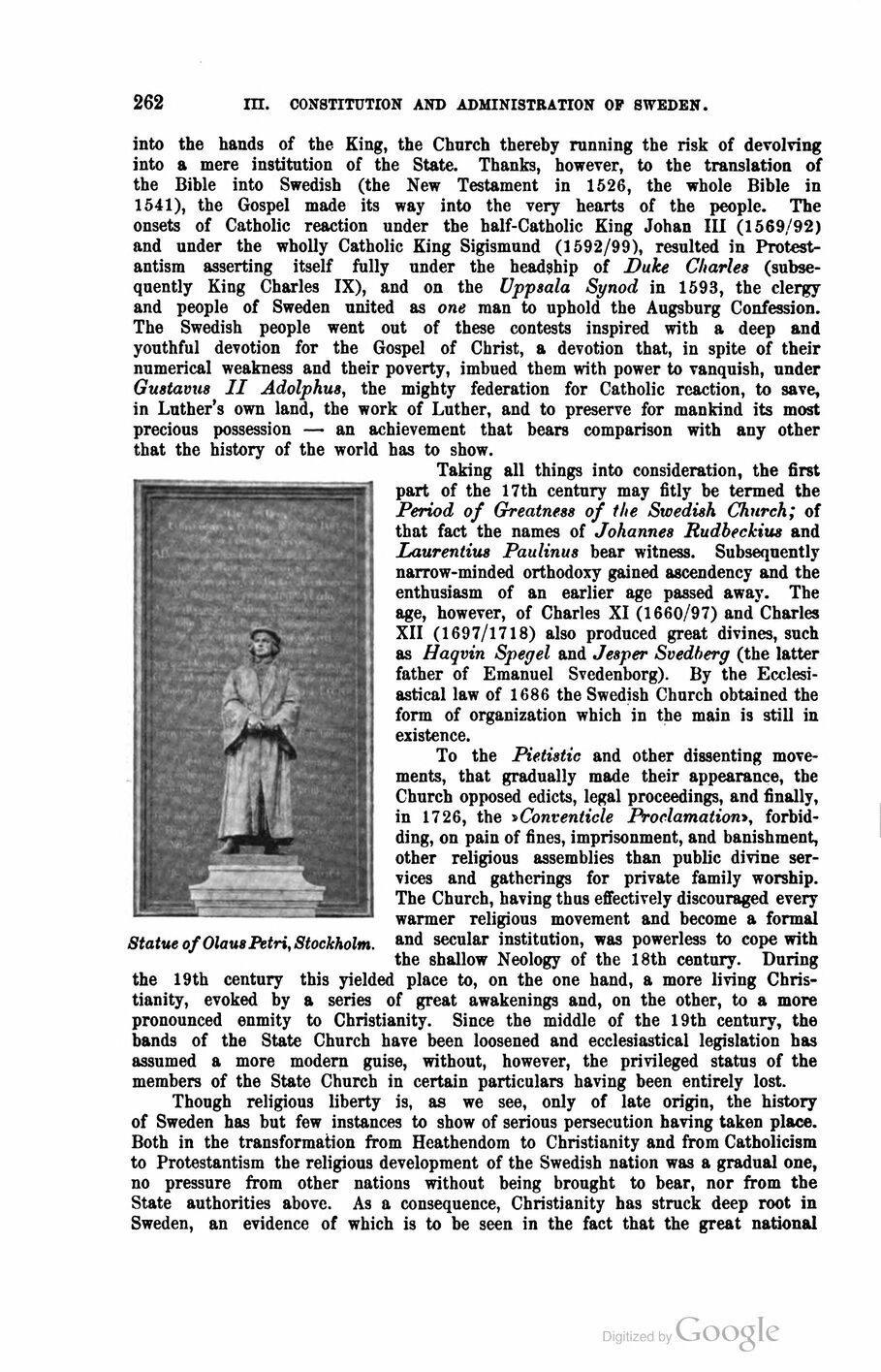
Full resolution (JPEG) - On this page / på denna sida - First part - III. Constitution and Administration - 4. Church and Religion. By G. Fr. Lundin, Ph. D., Uppsala

<< prev. page << föreg. sida << >> nästa sida >> next page >>
Below is the raw OCR text
from the above scanned image.
Do you see an error? Proofread the page now!
Här nedan syns maskintolkade texten från faksimilbilden ovan.
Ser du något fel? Korrekturläs sidan nu!
This page has never been proofread. / Denna sida har aldrig korrekturlästs.
262
iii. constitution and administration Of sweden.
into the hands of the King, the Church thereby running the risk of devolving
into a mere institution of the State. Thanks, however, to the translation of
the Bible into Swedish (the New Testament in 1526, the whole Bible in
1541), the Gospel made its way into the very hearts of the people. The
onsets of Catholic reaction under the half-Catholic King Johan III (1569/92)
and under the wholly Catholic King Sigismund (1592/99), resulted in
Protestantism asserting itself fully under the headship of Duke Charles
(subsequently King Charles IX), and on the Uppsala Synod in 1593, the clergy
and people of Sweden united as one man to uphold the Augsburg Confession.
The Swedish people went out of these contests inspired with a deep and
youthful devotion for the Gospel of Christ, a devotion that, in spite of their
numerical weakness and their poverty, imbued them with power to vanquish, under
Gustavus II Adolphus, the mighty federation for Catholic reaction, to save,
in Luther’s own land, the work of Luther, and to preserve for mankind its most
precious possession — an achievement that bears comparison with any other
that the history of the world has to show.
Taking all things into consideration, the first
part of the 17th century may fitly be termed the
Period of Greatness of the Swedish Church; of
that fact the names of Johannes Rudbeckius and
Laurentius Paulinus bear witness. Subsequently
narrow-minded orthodoxy gained ascendency and the
enthusiasm of an earlier age passed away. The
age, however, of Charles XI (1660/97) and Charles
XII (1697/1718) also produced great divines, such
as Haqvin Spegel and Jesper Svedberg (the latter
father of Emanuel Svedenborg). By the
Ecclesiastical law of 1686 the Swedish Church obtained the
form of organization which in the main is still in
existence.
To the Pietistic and other dissenting
movements, that gradually made their appearance, the
Church opposed edicts, legal proceedings, and finally,
in 1726, the »Conventicle Proclamation»,
forbidding, on pain of fines, imprisonment, and banishment,
other religious assemblies than public divine
services and gatherings for private family worship.
The Church, having thus effectively discouraged every
warmer religious movement and become a formal
and secular institution, was powerless to cope with
the shallow Neology of the 18th century. During
the 19th century this yielded place to, on the one hand, a more living
Christianity, evoked by a series of great awakenings and, on the other, to a more
pronounced enmity to Christianity. Since the middle of the 19th century, the
bands of the State Church have been loosened and ecclesiastical legislation has
assumed a more modern guise, without, however, the privileged status of the
members of the State Church in certain particulars having been entirely lost.
Though religious liberty is, as we see, only of låte origin, the history
of Sweden has but few instances to show of serious persecution having taken place.
Both in the transformation from Heathendom to Christianity and from Catholicism
to Protestantism the religious development of the Swedish nation was a gradual one,
no pressure from other nations without being brought to bear, nor from the
State authorities above. As a consequence, Christianity has struck deep root in
Sweden, an evidence of which is to be seen in the fact that the great national
Statue of Olaus Petri, Stockholm.
<< prev. page << föreg. sida << >> nästa sida >> next page >>